 Java
Java
 javaTutorial
javaTutorial
 How to build Dubbo project with SpringBoot to implement the nth term of Fibonacci
How to build Dubbo project with SpringBoot to implement the nth term of Fibonacci
How to build Dubbo project with SpringBoot to implement the nth term of Fibonacci
step1 Create a new project
Method 1: Create a new project directly in IDEA as shown:

Method 2: Create a new
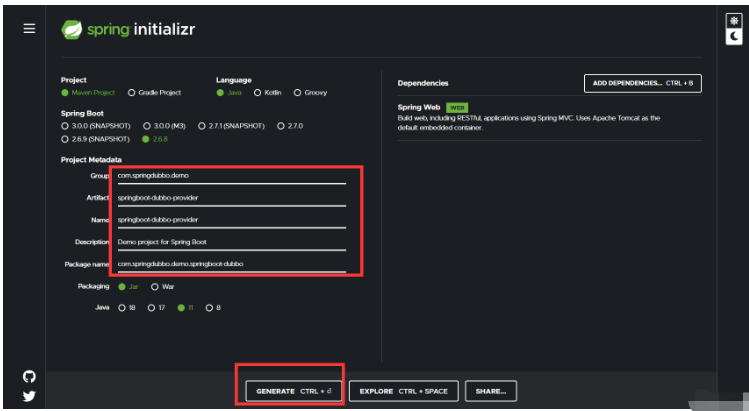
in start.spring.io. Some children may have discovered that the Server URL of the first method is the second website, which is the same.
To create two new projects, the first project is as shown in the picture above, and the second project only needs to change the provider to consumer
The rest remains unchanged, open it through IDEA after decompression
step2 Create the required packages, interfaces and implementation classes
provider project structure:

consumer project structure:
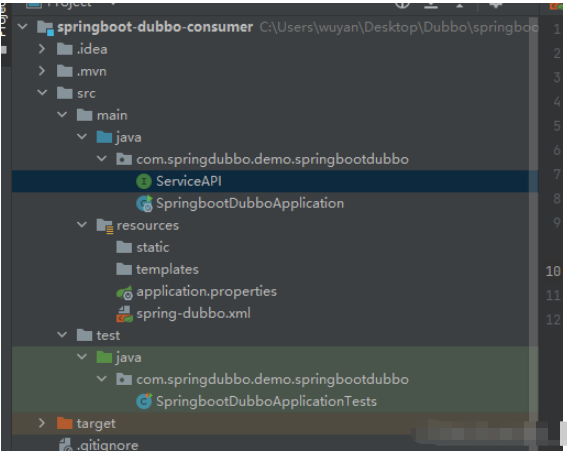
Please note that the locations of the two ServiceAPIs in the project, or the package names, must be strictly consistent, otherwise problems will occur later
If they are inconsistent, you can press them as needed as follows Make changes
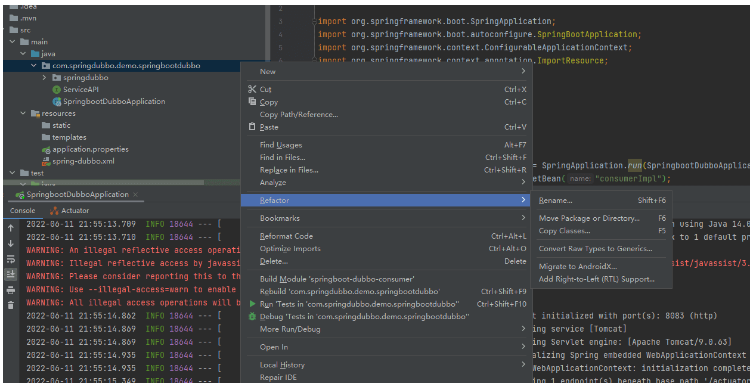
xsd and place it in the specified directory:
C:\Users\username\.lemminx\cache\http\code. alibabatech.com\schema\dubbo
File:dubbo.xsd
#step3 Create a new configuration file under the resources of the two projects
The name that needs to be created is: spring-dubbo.xml
In the configuration file of provider, write:
<?xml version="1.0" encoding="UTF-8"?>
<beans xmlns="http://www.springframework.org/schema/beans"
xmlns:xsi="http://www.w3.org/2001/XMLSchema-instance"
xmlns:dubbo="http://code.alibabatech.com/schema/dubbo"
xsi:schemaLocation="http://www.springframework.org/schema/beans
http://www.springframework.org/schema/beans/spring-beans.xsd
http://code.alibabatech.com/schema/dubbo http://code.alibabatech.com/schema/dubbo/dubbo.xsd">
<!-- dubbo应用名称 -->
<dubbo:application name="springboot-buddo-provider"/>
<!-- 发布者 dubbo协议 -->
<dubbo:protocol name="dubbo" port="20881"/>
<!-- 定义bean -->
<bean id="providerImpl" class="com.springdubbo.demo.springbootdubbo.apiImpl.ProviderImpl"/>
<!-- dubbo服务 发布者发布服务 需要暴露的服务接口 -->
<dubbo:service interface="com.springdubbo.demo.springbootdubbo.ServiceAPI" ref="providerImpl"
registry="N/A"/>
</beans>In the configuration file of consumer, write:
<?xml version="1.0" encoding="UTF-8"?>
<beans xmlns="http://www.springframework.org/schema/beans"
xmlns:xsi="http://www.w3.org/2001/XMLSchema-instance"
xmlns:dubbo="http://code.alibabatech.com/schema/dubbo"
xsi:schemaLocation="http://www.springframework.org/schema/beans
http://www.springframework.org/schema/beans/spring-beans.xsd
http://code.alibabatech.com/schema/dubbo http://code.alibabatech.com/schema/dubbo/dubbo.xsd">
<!-- dubbo应用名称 -->
<dubbo:application name="springboot-buddo-consumer"/>
<!-- 远程服务调用代理 -->
<dubbo:reference id="consumerImpl"
interface="com.springdubbo.demo.springbootdubbo.ServiceAPI"
url="dubbo://localhost:20881" />
</beans>step4 Code writing
Import dependencies
Add dependencies under the pom.xml of both projects:
<dependency> <groupId>com.alibaba.spring.boot</groupId> <artifactId>dubbo-spring-boot-starter</artifactId> <version>2.0.0</version> </dependency>
provider
ProviderImpl
Don’t forget to add the Service annotation, and it must be dubbo’s Service
package com.springdubbo.demo.springbootdubbo.apiImpl;
import com.alibaba.dubbo.config.annotation.Service;
import com.springdubbo.demo.springbootdubbo.ServiceAPI;
/**
* @author wuyt
* @data 2022/6/11
* @apiNote
*/
@Service
public class ProviderImpl implements ServiceAPI {
public String getMessage(String message) {
return "springboot-dubbo-provider =>>>>>" + message;
}
public String getTheFeibN(int n) {
//斐波那契数列第n项的实现逻辑
}
}ServiceAPI
package com.springdubbo.demo.springbootdubbo;
/**
* @author wuyt
* @data 2022/6/11
* @apiNote
*/
public interface ServiceAPI {
public String getMessage(String message);
public String getTheFeibN(int n);
}SpringbootDubboApplication
Be sure to add the ImportResource annotation
package com.springdubbo.demo.springbootdubbo;
import org.springframework.boot.SpringApplication;
import org.springframework.boot.autoconfigure.SpringBootApplication;
import org.springframework.context.annotation.ImportResource;
@SpringBootApplication
@ImportResource("classpath:spring-dubbo.xml")
public class SpringbootDubboApplication {
public static void main(String[] args) {
SpringApplication.run(SpringbootDubboApplication.class, args);
}
}consumer
ServiceAPI
package com.springdubbo.demo.springbootdubbo;
/**
* @author wuyt
* @data 2022/6/11
* @apiNote
*/
public interface ServiceAPI {
public String getMessage(String message);
public String getTheFeibN(int n);
}SpringbootDubboApplication
package com.springdubbo.demo.springbootdubbo;
import org.springframework.boot.SpringApplication;
import org.springframework.boot.autoconfigure.SpringBootApplication;
import org.springframework.context.ConfigurableApplicationContext;
import org.springframework.context.annotation.ImportResource;
@SpringBootApplication
@ImportResource("classpath:spring-dubbo.xml")
public class SpringbootDubboApplication {
public static void main(String[] args) {
ConfigurableApplicationContext count = SpringApplication.run(SpringbootDubboApplication.class, args);
ServiceAPI impl = (ServiceAPI)count.getBean("consumerImpl");
// System.out.println(impl.getMessage("Hello dubbo"));
System.out.println(impl.getTheFeibN(10));
}
}Port conflict change
You can modify the port number of either provider or consumer
Modify the port number of the consumer running here:
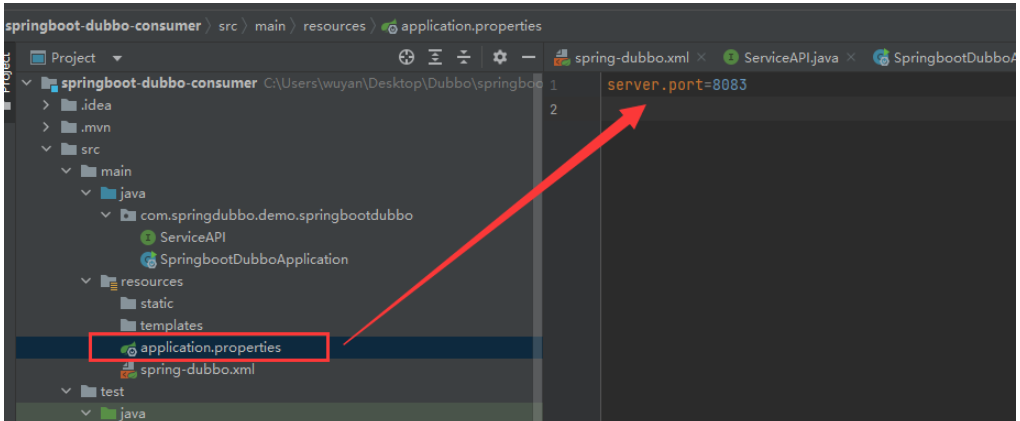
step5 Run
First run the provider, then run the consumer
Result:
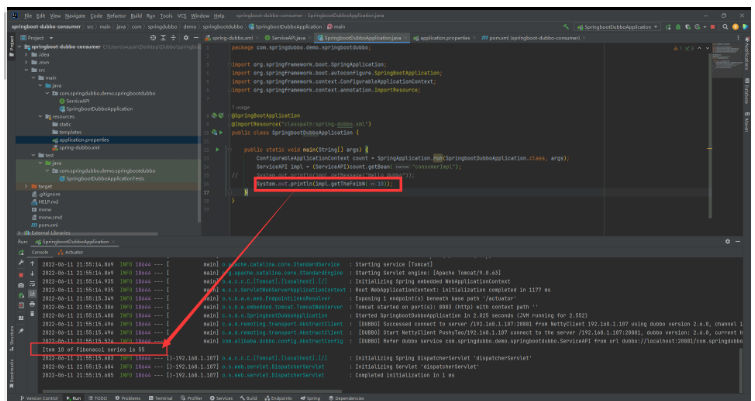
The above is the detailed content of How to build Dubbo project with SpringBoot to implement the nth term of Fibonacci. For more information, please follow other related articles on the PHP Chinese website!

Hot AI Tools

Undresser.AI Undress
AI-powered app for creating realistic nude photos

AI Clothes Remover
Online AI tool for removing clothes from photos.

Undress AI Tool
Undress images for free

Clothoff.io
AI clothes remover

Video Face Swap
Swap faces in any video effortlessly with our completely free AI face swap tool!

Hot Article

Hot Tools

Notepad++7.3.1
Easy-to-use and free code editor

SublimeText3 Chinese version
Chinese version, very easy to use

Zend Studio 13.0.1
Powerful PHP integrated development environment

Dreamweaver CS6
Visual web development tools

SublimeText3 Mac version
God-level code editing software (SublimeText3)

Hot Topics
 1387
1387
 52
52
 How Springboot integrates Jasypt to implement configuration file encryption
Jun 01, 2023 am 08:55 AM
How Springboot integrates Jasypt to implement configuration file encryption
Jun 01, 2023 am 08:55 AM
Introduction to Jasypt Jasypt is a java library that allows a developer to add basic encryption functionality to his/her project with minimal effort and does not require a deep understanding of how encryption works. High security for one-way and two-way encryption. , standards-based encryption technology. Encrypt passwords, text, numbers, binaries... Suitable for integration into Spring-based applications, open API, for use with any JCE provider... Add the following dependency: com.github.ulisesbocchiojasypt-spring-boot-starter2. 1.1Jasypt benefits protect our system security. Even if the code is leaked, the data source can be guaranteed.
 How to use Redis to implement distributed locks in SpringBoot
Jun 03, 2023 am 08:16 AM
How to use Redis to implement distributed locks in SpringBoot
Jun 03, 2023 am 08:16 AM
1. Redis implements distributed lock principle and why distributed locks are needed. Before talking about distributed locks, it is necessary to explain why distributed locks are needed. The opposite of distributed locks is stand-alone locks. When we write multi-threaded programs, we avoid data problems caused by operating a shared variable at the same time. We usually use a lock to mutually exclude the shared variables to ensure the correctness of the shared variables. Its scope of use is in the same process. If there are multiple processes that need to operate a shared resource at the same time, how can they be mutually exclusive? Today's business applications are usually microservice architecture, which also means that one application will deploy multiple processes. If multiple processes need to modify the same row of records in MySQL, in order to avoid dirty data caused by out-of-order operations, distribution needs to be introduced at this time. The style is locked. Want to achieve points
 How to solve the problem that springboot cannot access the file after reading it into a jar package
Jun 03, 2023 pm 04:38 PM
How to solve the problem that springboot cannot access the file after reading it into a jar package
Jun 03, 2023 pm 04:38 PM
Springboot reads the file, but cannot access the latest development after packaging it into a jar package. There is a situation where springboot cannot read the file after packaging it into a jar package. The reason is that after packaging, the virtual path of the file is invalid and can only be accessed through the stream. Read. The file is under resources publicvoidtest(){Listnames=newArrayList();InputStreamReaderread=null;try{ClassPathResourceresource=newClassPathResource("name.txt");Input
 How to implement Springboot+Mybatis-plus without using SQL statements to add multiple tables
Jun 02, 2023 am 11:07 AM
How to implement Springboot+Mybatis-plus without using SQL statements to add multiple tables
Jun 02, 2023 am 11:07 AM
When Springboot+Mybatis-plus does not use SQL statements to perform multi-table adding operations, the problems I encountered are decomposed by simulating thinking in the test environment: Create a BrandDTO object with parameters to simulate passing parameters to the background. We all know that it is extremely difficult to perform multi-table operations in Mybatis-plus. If you do not use tools such as Mybatis-plus-join, you can only configure the corresponding Mapper.xml file and configure The smelly and long ResultMap, and then write the corresponding sql statement. Although this method seems cumbersome, it is highly flexible and allows us to
 Comparison and difference analysis between SpringBoot and SpringMVC
Dec 29, 2023 am 11:02 AM
Comparison and difference analysis between SpringBoot and SpringMVC
Dec 29, 2023 am 11:02 AM
SpringBoot and SpringMVC are both commonly used frameworks in Java development, but there are some obvious differences between them. This article will explore the features and uses of these two frameworks and compare their differences. First, let's learn about SpringBoot. SpringBoot was developed by the Pivotal team to simplify the creation and deployment of applications based on the Spring framework. It provides a fast, lightweight way to build stand-alone, executable
 How SpringBoot customizes Redis to implement cache serialization
Jun 03, 2023 am 11:32 AM
How SpringBoot customizes Redis to implement cache serialization
Jun 03, 2023 am 11:32 AM
1. Customize RedisTemplate1.1, RedisAPI default serialization mechanism. The API-based Redis cache implementation uses the RedisTemplate template for data caching operations. Here, open the RedisTemplate class and view the source code information of the class. publicclassRedisTemplateextendsRedisAccessorimplementsRedisOperations, BeanClassLoaderAware{//Declare key, Various serialization methods of value, the initial value is empty @NullableprivateRedisSe
 How to get the value in application.yml in springboot
Jun 03, 2023 pm 06:43 PM
How to get the value in application.yml in springboot
Jun 03, 2023 pm 06:43 PM
In projects, some configuration information is often needed. This information may have different configurations in the test environment and the production environment, and may need to be modified later based on actual business conditions. We cannot hard-code these configurations in the code. It is best to write them in the configuration file. For example, you can write this information in the application.yml file. So, how to get or use this address in the code? There are 2 methods. Method 1: We can get the value corresponding to the key in the configuration file (application.yml) through the ${key} annotated with @Value. This method is suitable for situations where there are relatively few microservices. Method 2: In actual projects, When business is complicated, logic
 SpringBoot+Dubbo+Nacos development practical tutorial
Aug 15, 2023 pm 04:49 PM
SpringBoot+Dubbo+Nacos development practical tutorial
Aug 15, 2023 pm 04:49 PM
This article will write a detailed example to talk about the actual development of dubbo+nacos+Spring Boot. This article will not cover too much theoretical knowledge, but will write the simplest example to illustrate how dubbo can be integrated with nacos to quickly build a development environment.



